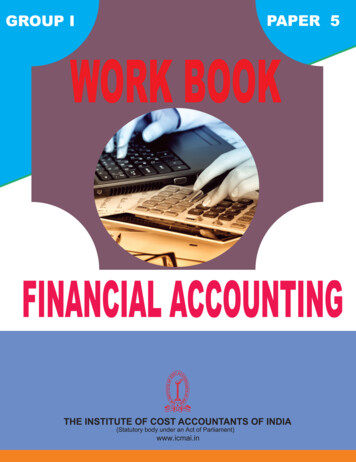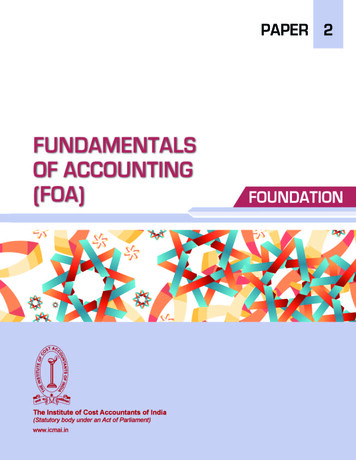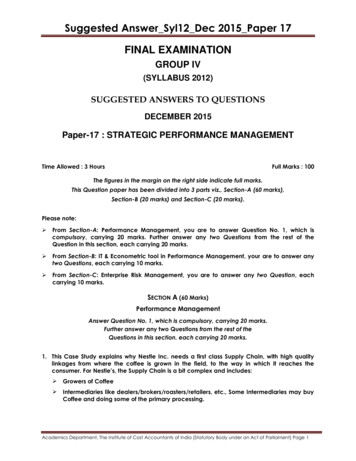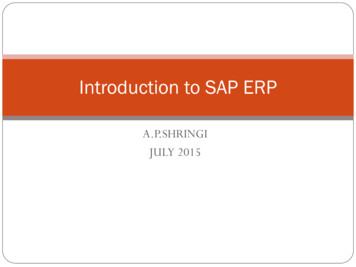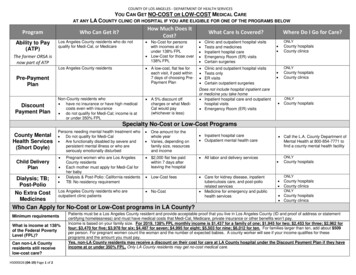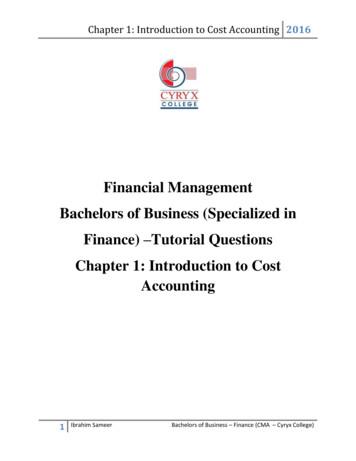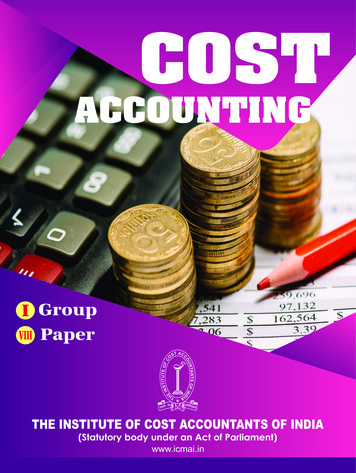
Transcription
WORK BOOKCOST ACCOUNTINGINTERMEDIATEGROUP – IPAPER – 8The Institute of Cost Accountants of India(Statutory body under an Act of Parliament)www.icmai.in
First Edition : March 2018Revised Edition : March 2019Published By :Directorate of StudiesThe Institute of Cost Accountants of IndiaCMA Bhawan, 12, Sudder Street, Kolkata – 700 016www.icmai.inCopyright of these study notes is reserved by the Institute of Cost Accountantsof India and prior permission from the Institute is necessary for reproduction ofthe whole or any part thereof.
PrefaceProfessional education systems around the world are experiencing great changebrought about by the global demand. Towards this end, we feel, it is our duty tomake our students fully aware about their curriculum and to make them moreefficient.Although it might be easy to think of the habits as a set of behaviours that we wantstudents to have so that we can get on with the curriculum that we need to cover.It becomes apparent that we need to provide specific opportunities for students topractice the habits. Habits are formed only through continuous practice. And topractice the habits, our curriculum, instruction, and assessments must providegenerative, rich, and provocative opportunities for using them.The main purpose of this volume is to disseminate knowledge and motivate ourstudents to perform better, as we are overwhelmed by their response afterpublication of the first edition. Thus, we are delighted to inform our students aboutthe e-distribution of the second edition of our ‘Work book’.This book has been written to meet the needs of students as it offers the practisingformat that will appeal to the students to read smoothly. Each chapter includesunique features to aid in developing a deeper under-standing of the chaptercontents for the readers. The unique features provide a consistent reading paththroughout the book, making readers more efficient to reach their goal.Discussing each chapter with illustrations integrate the key components of thesubjects. In the second edition, we expanded the coverage in some areas andcondensed others.It is our hope and expectation that this second edition of work book will providefurther an effective learning experience to the students like the first edition.The Directorate of Studies,The Institute of Cost Accountants of India
Work Book : Cost AccountingCOST ACCOUNTINGINTERMEDIATEGROUP – IPAPER – 8INDEXSl.Page No.No.1Introduction to Cost Accounting1–62Cost Ascertainment – Elements of Cost7 – 203Cost Accounting Standards21 – 264Cost Book Keeping27 – 515Methods of Costing52 – 1166Cost Accounting Techniques117 – 176Directorate of Studies, The Institute of Cost Accountants of India (Statutory Body under an Act of Parliament)
Suggested Marks Distribution from Examination Point of ViewOnly for Practice PurposePaper-5/6/7/8/11Total 100 Marks[3 Hours]Paper-9/10/12Objective 25 Marks 28 MarksOthers 75 Marks 72 MarksObjective Question25 Marks/28 Marks(1 Mark each questions)MCQ1 markMatchTrue/FalseFill in the Blanks1 mark1 mark1 markShort Notes / Case StudyMinimum Marks for each Questions4 MarksMaximum Marks for each Questions10 MarksPractical ProblemMinimum Marks for each Questions4 MarksMaximum Marks for each Questions15 Marks
Work Book : Cost AccountingStudy Note – 1INTRODUCTION TO COST ACCOUNTINGSection –ALearning Objective: This chapter discusses and explains the objectives and significanceof Cost Accounting and its relationship to Financial Accounting with the elements andclassification of cost.1.What is the distinction between Financial Accounting and Cost Accounting?Answer:The main differences between Financial and Cost Accounting are as follows:Financial AccountingCost Accounting(a) It provides the information about the business in (a) It provides information to the management fora general way. i.e Profit and Loss Account,proper planning, operation, control and decisionBalance Sheet of the business to owners andmaking.other outside partners.(b) It classifies, records and analyses the transactions (b) It records the expenditure in an objectivein a subjective manner, i.e according to themanner, i.e according to the purpose for whichnature of expense.the costs are incurred.(c) It lays emphasis on recording aspect without (c) It provides a detailed system of control forattaching any importance to control.materials, labour and overhead costs with thehelp of standard costing and budgetary control.(d) It reports operating results and financial position (d) It gives information through cost reports tousually at the end of the year.management as and when desired.(e) Financial Accounts are accounts of the whole (e) Cost Accounting is only a part of the financialbusiness. They are independent in nature.accounts and discloses profit or loss of eachproduct, job or service.(f)Financial Accounts records all the commercial (f)transactions of the business and include allexpenses i.e Manufacturing, Office, Selling etc.CostAccountingrelatestotransactionsconnected with Manufacturing of goods andservices, means expenses which enter intoproduction.(g) Financial Accounts are concerned with external (g) Cost Accounts are concerned with internaltransactions i.e transactions between businesstransactions, which do not involve any cashconcern and third party.payment or receipt.(h) Only transactions which can be measured in (h) Non-Monetary information like No of Units / Hoursmonetary terms are recorded.etc are used.Directorate of Studies, The Institute of Cost Accountants of India (Statutory Body under an Act of Parliament)Page 1
Work Book : Cost Accounting(i)Financial Accounting deals with actual figures (i)and facts only.Cost Accounting deals with partly facts andfigures and partly estimates / standards.(j)Financial Accounting do not provide information (j)on efficiencies of various workers / Plant &Machinery.Cost Accounts provide valuable information onthe efficiencies of employees and Plant &Machinery.(k)Stocks are valued at Cost or Market price (k)whichever is lower.Stocks are valued at Cost only.(l)Financial Accounting is a positive science as it is (l)subject to legal rigidity with regarding topreparation of financial statements.Cost Accounting is not only positive science butalso normative because it includes techniques ofbudgetary control and standard costing.(m) These accounts are kept in such away to meet (m) Generally Cost Accounts are kept voluntarily tothe requirements of Companies Act as per Secmeet the requirements of the management, only128 & Income Tax Act Sec 44AA.in some industries Cost Accounting records arekept as per the Companies Act.2.What are the different elements of cost?Answer:The elements of cost are shown in the following table:Material Direct IndirectLabour Direct IndirectExpenses Direct Indirect(Overheads)Direct Materials: Materials the costs of which can be attributed to a cost object in an economically feasibleway.Indirect Materials: Materials, the costs of which cannot be directly attributed to a particular cost object.Direct Employee Cost: Employee cost, which can be attributed to a Cost object in an economicallyfeasible way.Indirect Employee Cost: Employee cost, which can not be directly attributed to a particular cost object.Direct Material Direct Labour (Direct Employee cost) Direct Expenses Prime CostIndirect Material Indirect Labour (Indirect Employee cost) Indirect Expenses OverheadsDirectorate of Studies, The Institute of Cost Accountants of India (Statutory Body under an Act of Parliament)Page 2
Work Book : Cost Accounting3.Write short notes on Cost Centre, Profit Centre, Responsibility Centre and Cost Unit.Answer:Cost centre (Please refer Cost Accounting Standard 13): cost centre can be termed as a location, aperson, or an item of equipment (or a group of them) in or connected with an undertaking, in relation towhich costs ascertained and used for the purpose of cost control. The determination of suitable costcentres as well as analysis of cost under cost centres is very helpful for periodical comparison and control ofcost. In order to obtain the cost of product or service, expenses should be suitably segregated to costcentre. In a manufacturing concern, the cost centres generally follow the pattern or layout of thedepartments or sections of the factory and accordingly, there are two main types of cost centres as:- (i)Production Cost Centre: These centres are engaged in production work i.e engaged in converting the rawmaterial into finished product, for example Machine shop, welding shops.etc (ii) Service Cost Centre:These centres are ancillary to and render service to production cost centres, for example PlantMaintenance, Administration.etc The number of cost centres and the size of each vary from oneundertaking to another and are dependent upon the expenditure involved and the requirements of themanagement for the purpose of control.Responsibility Centre: A responsibility centre in Cost Accounting denotes a segment of a businessorganization for the activities of which responsibility is assigned to a specific person. Thus a factory may besplit into a number of centres and a supervisor is assigned with the responsibility of each centre. All costsrelating to the centre are collected and the Manager responsible for such a cost centres judged byreference to the activity levels achieved in relation to costs. Even an individual machine may be treated asresponsibility centre for cost control and cost reduction.Profit Centre: Profit centre is a segment of a business that is responsible for all the activities involved in theproduction and sales of products, systems and services. Thus a profit centre encompasses both costs that itincurs and revenue that it generates. Profit centres are created to delegate responsibility to individuals andmeasure their performance. In the concept of responsibility accounting, profit centres are sometimes alsoresponsible for the investment made for the centre. The profit is related to the invested capital. Such aprofit centre may also be termed as investment centre.Cost Unit: Cost Unit is a device for the purpose of breaking up or separating costs into smaller sub divisionsattributable to products or services. Cost unit can be defined as a ‘Unit of product or service in relation towhich costs are ascertained’. The cost unit is the narrowest possible level of cost object. It is the unit ofquantity of product, service of time (or combination of these) in relation to which costs may be ascertainedor expressed. We may, for instance, determine service cost per tonne of steel, per tonne-kilometre of atransport service or per machine hour. Sometimes, a single order or contract constitutes a cost unit which isknown as a job. A batch which consists of a group of identical items and maintains its identity through oneor more stages or production may also be taken as a cost unit. A few typical examples of cost units aregiven below:Directorate of Studies, The Institute of Cost Accountants of India (Statutory Body under an Act of Parliament)Page 3
Work Book : Cost AccountingIndustry/ Product4.Cost UnitAutomobileNumber of vehiclesCableMetres / kilometresCementTonneChemicals/ FertilizersLitre / KilogramGastonne Gas Cubic MetrePower/ electricityKilowatt HourTransportKilometre, Passenger-KilometreHospitalPatient Day Hotel Bed NightEducationStudent yearTelecomNumber of CallsBPO ServiceAccounts handledProfessional ServiceChargeable HoursDistinguish between cost reduction and cost control.Answer:Both Cost Reduction and Cost Control are efficient tools of management but their concepts andprocedure are widely different. The differences are summarised below:Cost Control(a) Cost Control represents effortstowards achieving target or goal.Cost Reductionmade (a) Cost Reduction represents the achievementin reduction of cost.(b) The process of Cost Control is to set up a (b) Cost Reduction is not concern withtarget, ascertain the actual performancemaintenance of performance according toand compare it with the target, investigatestandard.the variances, and take remedial measures.(c) Cost Control assumes the existence of (c) Cost Reduction assumes the existencestandards or norms which are notconcealed potential savings in standardschallenged.norms which are therefore subjected toconstant challenge with a viewimprovement by bringing out savings.oforato(d) Cost Control is a preventive function. Costs (d) Cost Reduction is a corrective function. Itare optimized before they are incurred.operates even when an efficient cost controlsystem exists. There is room for reduction in theachieved costs under controlled conditions.(e) Cost Control lacks dynamic approach.(e) Cost Reduction is a continuous process ofanalysis by various methods of all the factorsaffecting costs, efforts and functions in anorganization. The main stress is upon the whyof a thing and the aim is to have continualeconomy in costs.Directorate of Studies, The Institute of Cost Accountants of India (Statutory Body under an Act of Parliament)Page 4
Work Book : Cost Accounting5.Define Explicit costs. How is it different from implicit costs?[4]Answer:Explicit costs: These costs are also known as out of pocket costs. They refer to those costs which involvesimmediate payment of cash. Salaries, wages, postage and telegram, interest on loan etc. are someexamples of explicit costs because they involve immediate cash payment. These payments are recordedin the books of account and can be easily measured. Main points of difference:The following are the main points of difference between explicit and implicit costs. (i) Implicit costs do notinvolve any immediate cash payment. As such they are also known as imputed costs or economic costs. (ii)Implicit costs are not recorded in the books of account but yet, they are important for certain types ofmanagerial decisions such as equipment replacement and relative profitability of two alternative coursesof action.5.Choose the Correct answer:1.Which of the following items is not included in preparation of Cost Sheet?(a) Carriage inward(b) Purchase returns(c) Sales commission(d) Interest paid2.Cost Control represents(a) efforts made towards achieving target or goal(b) the achievement in reduction of cost(c) existence of concealed potential savings in standards or norms(d) a corrective functionAnswer:1.(d) Interest paid2.(b) efforts made towards achieving target or goal6.Match the following:AAutomobileAccounts HandledBCementNumber of vehiclesCBPOKilometre, Passenger-KilometreDTransportTonneETelecomPatient Day Hotel Bed NightFHospitalNo of callsDirectorate of Studies, The Institute of Cost Accountants of India (Statutory Body under an Act of Parliament)Page 5
Work Book : Cost AccountingAnswer:7.AAutomobileNumber of vehiclesBCementTonneCBPOAccounts HandledDTransportKilometre, Passenger-KilometreETelecomNo of callsFHospitalPatient Day Hotel Bed NightTrue or False:1.Cost centre is a location, person or item of equipment for which cost may be ascertained(T)2.Implicit costs involve immediate cash payment(F)Answer:1.True2.False8.Fill in the blanks:1.Costs which involves immediate payment of cash. Salaries, wages, etc is known as .2.Centre is a segment of a business that is responsible for all the activities involved in the production andsales of products, systems and services is called .Answer:1.Explicit cost2.Cost centreDirectorate of Studies, The Institute of Cost Accountants of India (Statutory Body under an Act of Parliament)Page 6
Work Book : Cost AccountingStudy Note – 2COST ASCERTAINMENT – ELEMENTS OF COSTLearning Objective: This chapter discusses cost ascertainment and elements of cost likeMaterial cost, Employee Costs, Direct expenses and Overheads.MATERIALS:1.Choose the correct answer:A.Which of the following is considered as normal loss of material?(a) Pilferage(b) Loss due to accident(c) Loss due to careless handling of material(d) None of the above.B.Which of the following is considered as normal loss of material?(a) Pilferage(b) Loss due to accident(c) Loss due to careless handling of material(d) None of the above.C.What is scrap?(a) Discarded material having no or insignificant value(b) Loss in the production process(c) Production that does not meet the quality requirements(d) None of the aboveAnswer:A.(c) Loss due to careless handling of materialB.(c) Loss due to careless handling of materialC.(a) Discarded material having no or insignificant value2.True /FalseA.Materials which can be identified with the given product unit cost centre is called as indirect materials.B.In case of materials that suffers loss in weight due to evaporation etc. The issue price of the materials isinflated to cover up the loss.Directorate of Studies, The Institute of Cost Accountants of India (Statutory Body under an Act of Parliament)Page 7
Work Book : Cost AccountingC.Spoilage is the production that does not meet the quality requirements or specifications and cannotbe rectified economically.D.Waste is the material lost during production or storage and discarded material which have very highvalue.Answer:A.FalseB.TrueC.TrueD.False3.Fill in the blanks:Material transfer note is a for transferring the materials from one job to other job.Answer:Material transfer note is a Document for transferring the materials from one job to other job.4.Match the following:AReorder levelRecord kept by storekeeperBDanger levelLevel of stock at which materials are orderedCBin cardRecord kept by cost departmentDStores ledgershall be absorbed in the cost of balancematerialENormal loss or spoilage shall be absorbed in materialof materialcost to the extent they are normalFLosses due to shrinkage Level of stock ofor evaporationproduction may stopAReorder levelLevel of stock at which materials are orderedBDanger levelLevel of stock of materialproduction may stopCBin cardRecord kept by storekeeperDStores ledgerRecord kept by cost departmentENormal loss or spoilage of shall be absorbed in the cost of balancematerialmaterialFLosses due to shrinkage shall be absorbed in material cost to the extentor evaporationthey are te of Studies, The Institute of Cost Accountants of India (Statutory Body under an Act of Parliament)Page 8
Work Book : Cost Accounting5.RST Limited has received an offer of quantity discount on its order of materials as under: Price per toneTones number 9,600 Less than 50 9,360 50 and less than 100 9,120 100 and less than 200 8,880 200and less than 300 8,640 300 and above The annual requirement for the material is 500 tonnes. Theordering cost per order is 12,500 and the stock holding cost is estimated at 25% of the material cost perannum.Required (i) Compute the most economical purchase level.[4]Answer:Order size4050100200300No. Of order1310532Cost of purchase(1)( )48,00,000(500 9600)46,80,000(500 9360)45,60,000(500 9120)44,40,000(500 8880)43,20,000(500 8640)Ordering cost (2)162500125000625003750025000Carrying cost (3)( )48,00058,5001,14,0002,22,0003,24,000Total cost (4) 1 2 3)( )50105004863500473650046995004669000The above table shows that the total cost of 500 units including ordering and carrying cost is minimum(46,69,000) where the order size is 300 units. Hence the most economical purchase level is 300 units.6.From the following information calculate Economic Order quantity (EOQ)Annual Consumption18000 unitsOrdering Cost 12 per orderCost per unit 1.50Obsolance8% of unit valueInsurance12% of unit valueAnswer:EOQ 2AB/CS 2 18,000 12 100/1.50 20 4,32,00,000/30 14,40,000 1,200 unitswhere,A Annual Consumption 18000 unitsB Ordering Cost 12C Cost per unit 1.50S Inventory Carrying Cost 20%.Directorate of Studies, The Institute of Cost Accountants of India (Statutory Body under an Act of Parliament)Page 9
Work Book : Cost Accounting7.In a factory component A is use
(e) Cost Accounting is only a part of the financial accounts and discloses profit or loss of each product, job or service. (f) Financial Accounts records all the commercial transactions of the business and include all expenses i.e Manufacturing, Office, Selling etc. (f)
